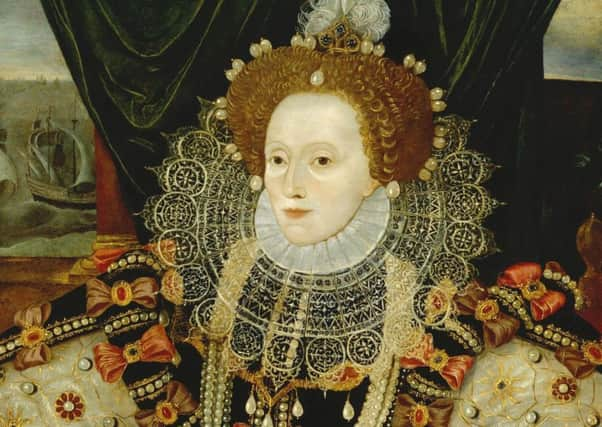Nostalgia: A combination of luck and guile secures the crown


It would be hard enough to confine the biography of almost anyone who had lived a full life into a few thousand words, and Elizabeth (1533-1603) had a life so (in)famous, memorable, eventful and extraordinary that dozens of reputable authors have spent decades studying it and trying to understand her. All that follows is simply a brief attempt to explain a few of the more interesting revelations of professional historians which have so far failed to alter the patriotic, popular perceptions of “Good Queen Bess” or the “Virgin Queen”.
We are all the product of our circumstances, of our birth, family, upbringing and social environment, and Elizabeth Tudor’s early experiences were so dramatic and compelling that they allowed her little room for her mature freewill.
Advertisement
Hide AdAdvertisement
Hide AdBorn into an age when religious faith and attachment were paramount, Elizabeth had no choice but to be a Protestant, in the same way that her elder half-sister, Mary, could not have been other than a Catholic. Mary’s claim to the English throne derived entirely from the legality of her mother’s marriage to Henry VIII; but Henry had this marriage to Catherine of Aragon declared null and void, contending that his first legitimate wife was Elizabeth’s mother, Anne Boleyn.
However, whereas the Catholic church regarded Anne as an adulterous, incestuous heretic and her daughter Elizabeth a bastard, Henry convinced himself that the Pope was wrong, his marriage to Catherine had been unlawful, and her failure to produce a male heir God’s punishment for their sin. As a result, all through her life, Elizabeth suffered the ignominy of being the daughter of adultery. Her elder half-sister referred to her as “the little whore”.
Elizabeth therefore owed her succession in 1558 to a favourable combination of luck and guile. Her younger, Protestant half-brother, Edward, died young and childless; her elder, Catholic half-sister, Mary, the next in line, died within five years of becoming queen, again childless. So Elizabeth took the crown as the third and last surviving offspring of Henry VIII.
Before then she might well have suffered the same ghastly fate on the block of her mother, of Lady Jane Grey and her followers, or as one of the 280 Protestant martyrs who were burned as heretics by order of Mary, if she had not behaved with exceptional diplomacy and duplicity.
Advertisement
Hide AdAdvertisement
Hide AdIn the end, ironically, it was the man who was to become her most powerful enemy, Philip II of Spain, who saved Elizabeth from her sister’s fanaticism. In the event of his wife’s failure to conceive an heir and her premature death. Philip’s intention was to marry Elizabeth himself and thereby prevent the succession to the English crown of the pro-French Mary, Queen of Scots.
Once crowned, Elizabeth continued to employ the same clever and evasive tactics that had secured her early survival. Her religious settlement, an astute middle course between the Protestant “hot gospellers” in the Commons and the Catholic bishops and nobility in the Lords, was passed narrowly by Parliament in 1559. One rare concession she made to her gender was to refuse her father’s title of “Supreme Head of the Church of Christ” and instead accept “Supreme Governor”, the title held by every English monarch ever since.
The Protestant church established under her brother Edward was essentially restored, but there were some subtle adjudgements to suit Catholic conservatives such as the insistence on clerical vestments, the retention of altars and the presence of God in the sacraments. The truth was that Elizabeth, unlike many of her subjects, was less interested in details of belief and more with matters of worship and practice and outward national conformity.
There was no question of religious toleration: all had to attend church, all had to use the same Book of Common Prayer, whether they agreed to it or not. Whereas Mary had burned Protestants for heresy, Elizabeth signed death warrants against traitors. She disliked fanatical Protestants and, at the same time and by the same token, despised dogmatic Catholics.
Advertisement
Hide AdAdvertisement
Hide AdUntil it became impossible, Elizabeth refused to act as the champion of European Protestantism. She kept Catholic Mary Queen of Scots locked up for 19 years and signed her death warrant with the greatest reluctance and only when the evidence against her was overwhelming. It took many years also before she finally agreed to send military aid to the Protestant Dutch fighting for their independence against Catholic Spain.
Eventually, however, she was made the principal target of the Catholic Counter-Reformation. In 1570, Pope Pius V declared her a heretic, excommunicated her and deprived her of her “pretended title” of queen. English Catholics were absolved from obedience to her: henceforth they were forced to choose between their church and their state.
In reply, Parliament’s Treasons Act described anyone who denied Elizabeth’s title as a traitor and Catholic emigres as “fugitives, rebels and traitors”. From then on, Catholic plots against Elizabeth, some invented by Walsingham’s counter-terrorist agents, but many genuine threats to her life, drove her and England to outright war with Philip II’s Spanish empire. The “cold war” between Elizabeth and Philip gradually intensified until it became a struggle for English survival against the threat of Spanish conquest.
[to be continued]